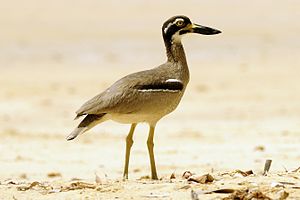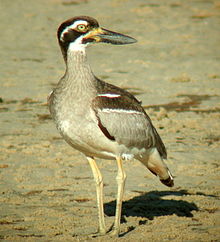Reef triel
| Reef triel | ||||||||||
|---|---|---|---|---|---|---|---|---|---|---|

Reef Triel ( Esacus giganteus ), Queensland, Australia |
||||||||||
| Systematics | ||||||||||
|
||||||||||
| Scientific name | ||||||||||
| Esacus giganteus | ||||||||||
| ( Vieillot , 1818) |
The reef triel ( Esacus giganteus , syn .: Esaus magnirostris ) is a species of bird from the family of the triele and the order of the plover-like . It occurs from the Malay Peninsula to New Guinea and the north and east of Australia.
The stock situation of Rifftriels is on the IUCN endangered with potentially ( near threatened ) specified. No subspecies are distinguished.
features
The reef triel reaches a body length of 54 to 56 centimeters and has a wingspan of 89 to 109 centimeters. The weight is about one kilogram.
The reef triel is a strongly built bird. His body is elongated, the chest protrudes far. Its neck is long and thin. Its massive, angular head has a huge, crescent-shaped beak. The legs are thin and long. The heel joint is very large. The bird has three long and one short toes. A black band stretches over the top of the head and on the eyes up to the neck. Between these bands, the plumage is white, as is the case on the throat. There is a small black line on the chin. This is bordered by a long, beige spot on the front of the neck. The front body of the reef triel is brown, the belly is white to beige. Its tail and wings are dark in color, and its lower arm feathers are gray. Two white and dark gray framed stripes run from the wrist over the arm wing. The beak tip is black, the beak shaft and legs are colored yellow. The undersides of the wings are white.
Habitat and Distribution
The reef triel occurs on tropical beaches, in mangroves and on coral reefs . It is native to the northern and eastern coasts of Australia , New Caledonia and the Malay Archipelago and the Philippines .
In Australia it occurs along the coasts from Western Australia to far into Southeast Australia. In New Guinea, the range of the reef triel is somewhat more disjoint . It occurs there mainly on isolated beaches and on small islets off the coast.
The migration behavior of reef trolleys has so far been little studied. Adult birds are considered to be resident birds , but random visitors often come far south of their usual range. However, they always stay close to the coast.
Way of life
The reef triel lives solitary or in pairs, only occasionally there are gatherings of up to six individuals. It occurs mainly where sandy beaches are largely isolated or where extensive tidal areas or mangroves are accessible. He is very shy towards people. It is predominantly crepuscular and nocturnal. During the day, he rests in the shade of trees in the coastal zone or stays on the edge of the mangrove.
The reef triel is in the shade or in shallow water during the day. At night and in the twilight he goes in search of food. He strides along the beach looking for prey such as crabs , clams , worms and other invertebrates . Occasionally it stays still for a longer period of time and thus lurks for prey. In its foraging, it is reminiscent of different species of heron. If he is in danger, he just runs away. This bird seldom and badly flies. Its nest is a hollow on the beach, formed by body pressure, next to driftwood, dishes and seaweed. The young are fleeing the nest .
Reefs and people
- Reefs are very sensitive to human disturbance. Beaches that are frequented by bathers no longer offer suitable breeding grounds.
- The eggs are more often illegally stolen by collectors.
Systematics
The species was first described by Vieillot in 1818 as Oedicnemus magnirostris , another synonym is Burhinus giganteus . According to Andrew (1992), the IUCN places it in the genus Esacus together with the crab troll ( E. recurvirostris ) , since a merger of the genus Esacus with the genus Burhinus proposed by Sibley and Monroe (1990, 1993) does not take into account that the two species stand out clearly from all other species of the genus Burhinus with their strong beaks, the black and white facial markings and the simplified back pattern. The specific epithet magnirostris is now commonly used.
literature
- Bruce M. Beehler, Thane K. Pratt: Birds of New Guinea; Distribution, Taxonomy, and Systematics . Princeton University Press, Princeton 2016, ISBN 978-0-691-16424-3 .
- Colin Harrison, Alan Greensmith: Birds of the World. Ravensburger Buchverlag, 1994, ISBN 3-473-46076-1
- PJ Higgins (Ed.): Handbook of Australian, New Zealand & Antarctic Birds , Volume 2, Raptors to Lapwings, Oxford University Press, Oxford 1993, ISBN 0-19-553069-1 .
Web links
Individual evidence
- ↑ a b Handbook of the Birds of the World on the Rifftriel accessed on June 5, 2017.
- ↑ a b Higgins (Ed.): Handbook of Australian, New Zealand & Antarctic Birds . Volume 2, p. 708.
- ↑ a b Higgins (Ed.): Handbook of Australian, New Zealand & Antarctic Birds . Volume 2, p. 709.
- ↑ Bruce M. Beehler, Thane K. Pratt: Birds of New Guinea . P. 164
- ↑ a b c d Higgins (Ed.): Handbook of Australian, New Zealand & Antarctic Birds . Volume 2, p. 710.
- ↑ Esacus magnirostris in the endangered Red List species the IUCN 2011. Posted by: BirdLife International, 2008. Accessed November 17, 2011th
- ^ P. Andrew: The birds of Indonesia: a checklist (Peters' sequence) , Indonesian Ornithological Society, Jakarta 1992.

